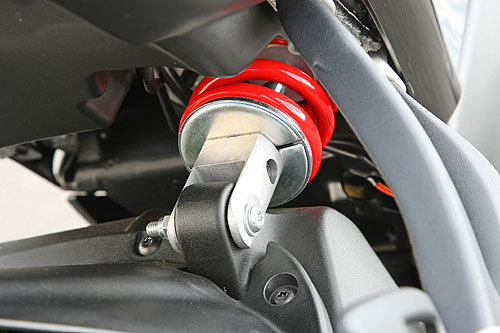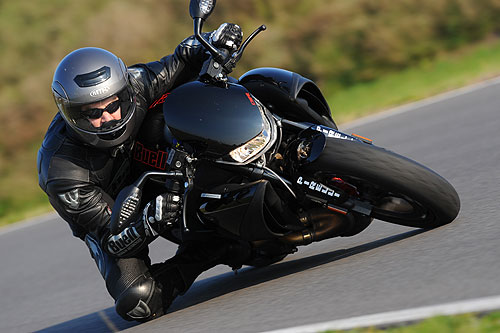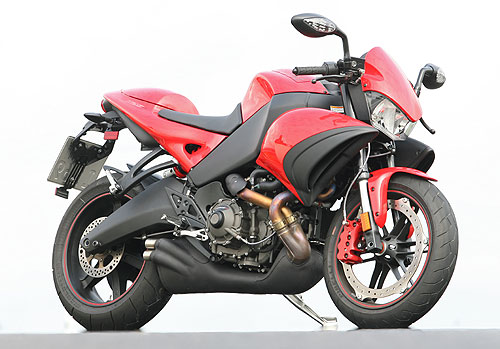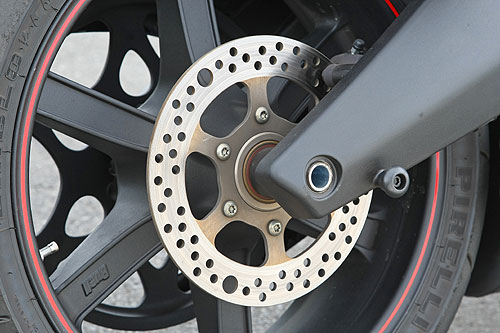Buell Über Alles
Buell 1125CR
Berlin, Germany
September 29-30, 2008
“I drew this bike 18 years ago. Four valve, liquid cooled, split radiators. I never dreamed it would take 18 years to get it built,” confided a jet lagged, but satisfied, Erik Buell. We are sitting around the hospitality section of a demountable garage at a test track an hour east of Berlin to sample the track manners of the 1125CR. The question was “Is it liberating to be able to source engines from Rotax?”
 Buell is now competitive with the world’s best on price and performance.
Buell is now competitive with the world’s best on price and performance.
The 1125CR is my first Buell riding experience. Although I have appreciated the ground breaking engineering of the marque in the past (fuel in frame, external brake rotor) I always felt that they were dancing around the obvious Achilles heel of the endeavor: the archaic power plant. It is simply not possible to build a modern sporting motorcycle, almost by definition, with a push rod, air-cooled engine.
Defying the expectation of using the V-Rod or a VR1000-derived engine worm its way into the Buell chassis, Erik has skipped over to Europe and enlisted Rotax to make engines to his specification for his new line of supersport bikes. These 1125cc 72-degree liquid cooled fuel injected engines are used in two of Buell’s current models: the faired 1125R and the relatively un-faired 1125CR (café racer).

The fuel is in the frame so there is no gas tank. The plastic is not painted; instead it is
a cutting edge polymer with embedded color. It is both tough and attractive. The 1125CR
comes embedded with either red or black plastic.
The new vendor relationship was not without its tribulations. Modern engine management is a complicated endeavor. Engine mapping (ignition and fuel injection) are incredibly difficult tasks as one balances the needs for power with the needs for legal emissions. In the case of the 1125R this task was further complicated by the use of a Buell-sourced fuel injection with which Rotax was unfamiliar as well as a bit of a technical language gap between the American and Austrian engineers.
The mix-up in language on ignition mapping led the Austrians to create an ignition map that would have been perfect for some of their other engines such as (off-road or aircraft) but was far too aggressive for a street going motorcycle. With the ignition map way too far advanced for a street bike, the fuel injection overcompensated by dumping in extra fuel. This led to very high engine and exhaust temperatures while also resulting in a poor fueling bike. The engine maps passed emissions but the fuel system was making up for the inefficient ignition system. This was the bike that Roadracing World tested last year (October 2007 issue of RRW&MT).

The muffler makes the bike quiet. Too quiet. Without the trickery of exhaust pipe valves to fake through noise tests the bikes are really quiet all through the rev range. The 72-degree twin is begging for a loud pipe.
Knowing something was amiss, Erik dispatched one of his bright young engineers to Austria. Looking at the graphs together they identified the issue and created new maps that boosted fuel economy and power while decreasing engine temperatures. Of course, before they could update all the bikes that were already sold they needed to wait for EPA approval for the remap.
Learning the German translation for “Spark Map” versus “Pressure Map” was a small price to pay for these excellent engines. The Rotax-built power plant has everything you want in a sporting twin. Nikasil liners, finger follower valve actuation hiding under magnesium covers, a massive over-square geometry (103 X 67.5) with big valves, high lift cams and huge 61mm throttle bodies. The three counter balancers create a deceptively smooth engine for its 146 bhp output. The geometry of this engine suggests that this motor is just beginning its life cycle and has lots of power that can still be wrested from its internals over the coming years.

“To compete in the global economy while maintaining American labor rates we need to be
more efficient. We need a single part to do two or three jobs. We need to be that much
better.” – E Buell
Having modern engines removed the last design constraint from Buell. To a certain extent the old school engines allowed the Buell to avoid a direct comparison to Ducati, Aprilia or other purveyors of sporting twins. With a level playing field Buell can’t really dodge those comparisons.
Not that Erik is the kind of guy who would ever dodge a fight. He is a true motorcycle enthusiast and is the most effective advocate for his company. He exudes enthusiasm for engineering, racing, and riding, and for how those activities enrich people’s lives. He has 200 people making 14,000 bikes a year. That is impossible to do without a committed and devoted staff.

Erik is a man filled with, as the French would say, ‘joy of life’. His indomitable spirit was
expressed at this moment as he demonstrated the strength of the bike’s polymer bodywork
to your correspondent by bending a tail section in half to reveal no cracks, no whitening
and no damage.
Without the apologist excuse of the engine supplier, Buell’s unconventional engineering will have to stand on its own. Erik is ready. “I do get tired of reading ‘my buddy is a racer and he says the Buell will never work.’ I always want to say ‘Who the fuck is your buddy and is he faster than Sean (Higbee)?’”
So I find myself in Germany wearing borrowed leathers and helmet (see: declining dollar = increased oil prices = unprofitable airlines = fired baggage handlers = luggage doesn’t make connection) about to ride my first Buell that, Erik assures me, is the pinnacle of naked sporting twins. The 1125CR is, for all intents and purposes, an 1125S without the upper fairing and with a top triple clamp that can accommodate tubular handlebars instead of the integrated cast clip-ons of the R that was introduced last year.
The track is a new venue in the shadow of Germany’s new trademark wind turbines. It is very tight with only one scant opportunity to touch fourth gear. Many of the turns are very slow and are thrown at the rider in combinations. Think Blawkhawk Farms or Talladega and you would be pretty close. The pavement was very smooth and grippy but there were a few unprotected barriers in some crash zones. The weather was cool but clear. The bikes were fitted with Pirelli Corsa III (120 X 17, 180 X 17) dual compound tires which are on the road end of Pirelli’s track – street tires.
Even recognizing that the key to happiness is low expectations, the Buell was a delight. After hearing horror stories of wildly out of range spring rates and damping settings, this Buell was almost perfect on the suspension front. The Showa units fitted front and back were obviously not specified for price alone and the damping movement was smooth, controlled and, most importantly, appropriate for the bike.

“Showa makes good stuff. You just have to ask for it.” –E Buell
The wide seat (read- comfortable), clubman handlebars and rear sets conspired to offer a riding position that was track appropriate but still managed to be all day comfortable. The hydraulic actuated, vacuum controlled slipper clutch had a reasonable level of adjustment in the lever as did the front brake. The bike felt perfectly natural to someone used to Japanese sportbikes. Picking the bike up off the stand revealed its low overall weight – at 375 lbs. it is well into sport bike territory, and the bike carries that weight low in the chassis.
The Buell has very aggressive steering geometry and an incredibly stiff chassis. I was anticipating a bike that was easy to ride at a brisk pace but that would begin to fall apart at a fast pace. I also anticipated being able to fade the single, though mammoth, brake on the many tight turns.

Nimble nimble nimble.
On this 65° day on this tight, slow, grippy track, both of those prejudices were unfounded. My initial reservations about trusting something different were overcome by the experience of the excellent front brake. With eight pistons the swept area is similar to a conventional dual disc set up. The leverage ratio of the master cylinder to the slaves was nice and progressive and Buell’s choice of brake pad is pretty aggressive. The result: a predictable and very powerful front brake. Now, on this track there is only one turn that really required much braking and it was only from fourth to second gear. Tracks like Summit Point or Road Atlanta might generate some brake disk heat issues but as this is a street bike the only time it should see Summit or Road A is on a track day and the brake is plenty powerful enough for track day antics.

With the rotor bolted to the rim the spokes can be smaller and lighter, so much so that
the front wheel & brake package is 6.8lbs lighter than a 2006 GSX-R 750.
The aggressive steering geometry worked. We were running dual compound Pirelli street tires. They were not the stickiest things in the world but instead of experiencing the abrupt front end tucks that I was dreading I was given quick precise steering that was very low effort. After riding six track sessions I wasn’t the least bit tired or sore. It was possible to overwhelm the rear’s grip with the power of the engine but pinning the throttle in fourth gear with knee down is not really the application for which the tire was designed
The transmission was positive and light, the vacuum assisted slipper clutch worked and I did not feel any pulsing at the lever like some of the other bikes with similar designs (See-Aprilia).

Cheeky jowl things are really cheap to replace in a parking lot tip over.
The lack of an upper fairing makes the protruding side mount radiator vents seem obtrusive from the front but offers sturdy protection for the rest of the bike in parking lot tip-overs (the plastic is impressively tough – see photo elsewhere) as well as air flow management.
The remapping of the fuel injection and ignition is just about perfect. The final belt drive has an idler pulley to take up slack, making the drive line almost lash free. Combined with the excellent low speed throttle response even full lean slow speed throttle transitions (off to on) were free from the polar bear friendly “lean stutter” that plagues many stock bikes.

With an idler system to take up slack on the drive belt there is no need for chain adjusters.
For racing applications there is a kit swingarm that allows for a chain conversion.
My only real complaint with the layout of the bike was that the clutch cover intrudes on the air space over the rear brake pedal making it slightly awkward to reach the lever. That is a small complaint.
The twin split radiators seemed a little undersized for the power output but Erik assured me that they are adequate for stop and go summer DC traffic. The dual fans for the radiators run almost continuously and even run for a bit once the engine is shut down. Ten 1125CRs, therefore, make quite the cacophony once the engines are shut down.
After a fully satisfying day at the track which determined that an experienced CR rider will have no issues participating in track days, we spent the next day touring through the countryside of eastern Germany.

The bar bend is the only retro piece on this bike.
We did a mix of roads including cobblestone, single lane back roads, dual carriageway and Autobahn. In addition to the clubman bar equipped 1125, Buell had brought along some bikes fitted with the optional high bar. The higher handlebar is about four inches further back towards the seat centerline and about three inches higher. Although the aesthetic difference is small, the change in the riding demeanor is dramatic. Whereas the clubman bar places the rider physically forward with a fair amount of wrist weight, the higher bar puts the weight on the relatively comfortable seat and puts the rider a bit more up into the wind. It changes the bike’s character from being a back road scratcher to a mid-town hooligan machine. I preferred the clubman bars for fast riding but the higher bars for the urban settings and the bumpy back roads.
Some of the Russian built roads were a little too bumpy for the compression damping settings in the bikes resulting in a riding experience that was similar to being beaten in a paint shaker. However, on smoother pavement the suspension did not disappoint and allowed for a comfortable yet aggressive street pace. This included about six minutes on the Autobahn where I was able to keep the bike pinned at a true 158 mph on a patchy damp and undulating superhighway. At those speeds the lack of a front fairing becomes a bit of an issue as my helmet was being crushed against my face and inhibiting my ability to breathe. If sustained 158 mph riding is in your future, get the 1125 with the fairing.
The CR comes with heated handgrips which were a welcome feature given the gloomy cool day and my ventilated street leathers. There is barely any vibration to mention. The instrument cluster has a variety of modes to display fuel consumption, various temperatures, miles left before engine service and a variety of trip computer functions.

“I wanted it to look aggressive – predatory – like a scorpion” – E Buell.
“It’s a fine line between ‘scorpion’ and ‘lobster.’” – SPQF
Although initially skeptical I came away from the two-day test suitably impressed with the bike. Removing the legacy engine shackles from Buell has allowed them to embark on an entirely new level of rider experience that in many cases without any compromises in their engineering or performance. The net result is that the 1125CR makes a great all around street motorcycle that, in the right hands, can humiliate faired bikes at track days.
